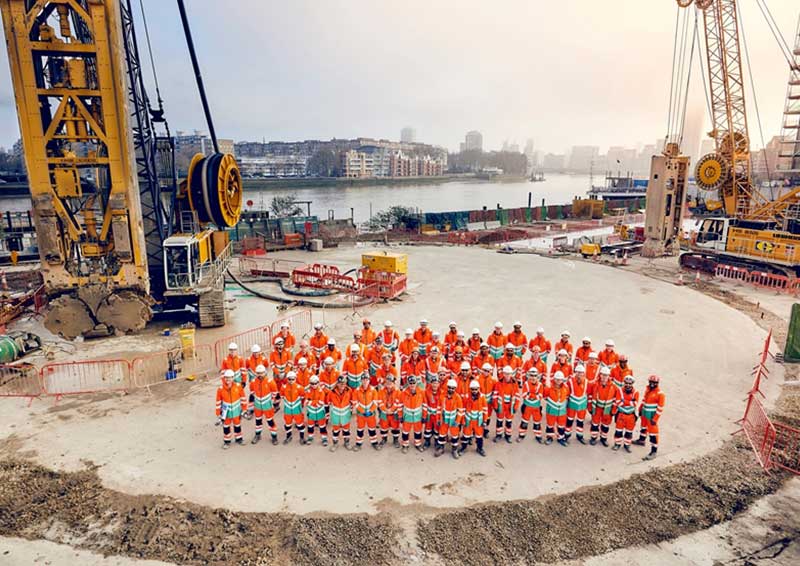Thames Tideway update
See our main article on Thames Tideway here.
Contents |
[edit] Introduction
Tideway, an independent licenced infrastructure provider consisting of a consortium of investors, has been making good progress with construction of London's new 25 km long 'super sewer', the £4.2 billion Thames Tideway tunnel (Stride, 2016).
Ahead of tunnelling in 2018, the main focus of work has been at the three main drive sites. These are for launching the 7.8 m diameter tunnel boring machines (TBMs) and will serve as material transport hubs and head offices for each of Tideway's three main NEC3 works contracts – west, central and east.
[edit] Drive site construction
Chambers Wharf in Bermondsey was one of the first to start, beginning with the removal of thousands of tonnes of contaminated spoil. This was the first opportunity for Tideway to use the river to transport materials, in this case from site to a location outside London for safe disposal.
At Chambers Wharf, the east team has constructed one of the largest new areas of London in over a century, with an infilled cofferdam of 744 piles creating nearly 1 ha of new foreshore. It will form the temporary construction platform for a 25 m diameter, 57 m deep launch shaft for the east TBM, which is due to start tunnelling in 2019.
At Kirtling Street near Battersea power station, Tideway's central team is building the main 33 m diameter double drive shaft, using a hydromill to create 42 shaft wall panels 86 m deep. The next task will be a new jetty to receive the two TBMs later in 2017, as well as for delivery and removal of materials by river.
The third drive site is at Carnwath Road in Fulham, where the west team has undertaken significant river-wall strengthening ahead of secant wall piling to create the launch shaft. Like all Tideway's drive sites, it comprises a number of brownfield land parcel and has required significant clearance and demolition.
[edit] Drop shaft enabling works
At Blackfriars, the central team has recently delivered a new £8 million river-boat pier, lift and stairs to connect river traffic and Blackfriars railway station for the first time. This has enabled removal of the existing Blackfriars pier, which in turn will allow construction of a 24 m diameter, 53 m deep drop shaft to intercept the Fleet Main combined sewer outfall (CSO) – one of 34 being picked up by the new tunnel.
At Victoria Embankment near the Houses of Parliament, the team has also moved the floating bar PS Tattershall Castle 125 m downstream to make room for a 13 m diameter shaft to intercept the Regent Street CSO.
In 2017, there will be noticeable progress on more than a dozen shaft sites across London, including delivery and assembly of TBMS at the west and central drive sites.
The project remains on schedule for completion in 2023, when it will provide a direct 7.2 m diameter link from storm tanks in Acton in the west to Beckton sewage treatment works in the east via the recently completed 6.9 km Lee tunnel.
[edit] Cutting untreated sewage flow
Together with sewage treatment works improvements, the Tideway and Lee tunnels will cut the untreated sewage which flows into the river each year from 39.5 Mt to just 2.4 Mt.
This article was originally published here on 3 Aug 2017 by ICE.
It was written by Andy Alder, Thames Tideway delivery manager, and Mike Appleton, communications executive.
--The Institution of Civil Engineers
[edit] Related articles on Designing Buildings Wiki.
Featured articles and news
RTPI leader to become new CIOB Chief Executive Officer
Dr Victoria Hills MRTPI, FICE to take over after Caroline Gumble’s departure.
Social and affordable housing, a long term plan for delivery
The “Delivering a Decade of Renewal for Social and Affordable Housing” strategy sets out future path.
A change to adoptive architecture
Effects of global weather warming on architectural detailing, material choice and human interaction.
The proposed publicly owned and backed subsidiary of Homes England, to facilitate new homes.
How big is the problem and what can we do to mitigate the effects?
Overheating guidance and tools for building designers
A number of cool guides to help with the heat.
The UK's Modern Industrial Strategy: A 10 year plan
Previous consultation criticism, current key elements and general support with some persisting reservations.
Building Safety Regulator reforms
New roles, new staff and a new fast track service pave the way for a single construction regulator.
Architectural Technologist CPDs and Communications
CIAT CPD… and how you can do it!
Cooling centres and cool spaces
Managing extreme heat in cities by directing the public to places for heat stress relief and water sources.
Winter gardens: A brief history and warm variations
Extending the season with glass in different forms and terms.
Restoring Great Yarmouth's Winter Gardens
Transforming one of the least sustainable constructions imaginable.
Construction Skills Mission Board launch sector drive
Newly formed government and industry collaboration set strategy for recruiting an additional 100,000 construction workers a year.
New Architects Code comes into effect in September 2025
ARB Architects Code of Conduct and Practice available with ongoing consultation regarding guidance.
Welsh Skills Body (Medr) launches ambitious plan
The new skills body brings together funding and regulation of tertiary education and research for the devolved nation.
Paul Gandy FCIOB announced as next CIOB President
Former Tilbury Douglas CEO takes helm.
UK Infrastructure: A 10 Year Strategy. In brief with reactions
With the National Infrastructure and Service Transformation Authority (NISTA).
























